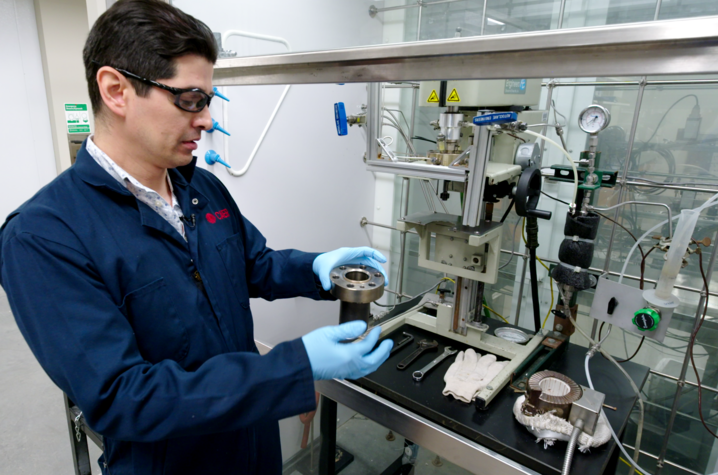CAER, state Energy and Environment Cabinet complete sustainable aviation fuel study

LEXINGTON, Ky. (Oct. 10, 2025) — The University of Kentucky Center for Applied Energy Research (UK CAER) and the Kentucky Energy and Environment Cabinet (EEC) have completed a risk assessment of representative fats, oils and grease (FOG) feedstocks that can be used to produce sustainable aviation fuel (SAF) in Kentucky. The project, funded by the Office of Energy Policy within EEC, is one of two SAF studies currently underway in Kentucky. The second, led by WSP, is funded by the Kentucky SAF Coalition.
The study identified corn oil as the safest bet for making SAF in Kentucky thanks to its low risk profile, according to Eduardo Santillan-Jimenez, Ph.D., associate director of CAER’s Sustainable and Alternative Fuels Research Group. He noted that such a finding can guide the decision-making of stakeholders interested in investing in SAF-related projects in the Commonwealth.
SAF is an alternative to jet fuel that can be made from everyday materials like plant oils, animal fats and recycled cooking grease, can be blended up to 50% with traditional jet fuel for use in commercial aircraft and represents a market potential of $80 billion globally (by 2035). Jet fuel is the fourth most consumed fuel in the Commonwealth and is critical for Kentucky’s three air hubs as well as for national defense aviation operations at the Kentucky National Guard, Fort Knox and Fort Campbell.
“As the aviation industry looks to diversify its fuel sources and become more sustainable, SAF represents an advanced energy economic development opportunity for Kentucky. It creates new markets for agricultural products, brings investment to processing infrastructure and directly supports fuel diversification and local production supporting Kentucky’s Energy Security Plan,” said Kenya Stump, executive director of the Kentucky Office of Energy Policy.
Essential to this growth, however, is understanding the supply chain risk necessary to attract infrastructure and manufacturing investments. The risk assessment conducted by UK CAER focused on soybean oil, corn oil and distillers corn oil — which are some of the most important agricultural commodities in Kentucky — as well as on animal fats (from livestock rendering), yellow grease (used cooking oil) and brown grease (FOG recovered from grease traps and/or from wastewater treatment plants).
Six types of risks were reviewed based on a U.S. Department of Energy standard that helps investors better understand the risks of using biomass as a resource, making it easier to support and grow the bioeconomy.
“Risk was highest in supplier and supply chain categories,” said Santillan-Jimenez. “The risk associated with the other categories was found to be low. Both yellow and brown grease show high supplier and supply chain risk, while soybean oil shows high supplier risk but medium supply chain risk. Notably, corn oil shows medium supplier risk and low supply chain risk, making it the less risky feedstock overall.”
For more information, please direct inquiries to the email address listed in this press release or attend the 2025 Governor's Conference on Energy and Environment this October where UK CAER’s Santillan-Jimenez and Auden Kaehler of WSP will share the findings of these studies with energy stakeholders from across the Commonwealth.
As the state’s flagship, land-grant institution, the University of Kentucky exists to advance the Commonwealth. We do that by preparing the next generation of leaders — placing students at the heart of everything we do — and transforming the lives of Kentuckians through education, research and creative work, service and health care. We pride ourselves on being a catalyst for breakthroughs and a force for healing, a place where ingenuity unfolds. It's all made possible by our people — visionaries, disruptors and pioneers — who make up 200 academic programs, a $476.5 million research and development enterprise and a world-class medical center, all on one campus.




